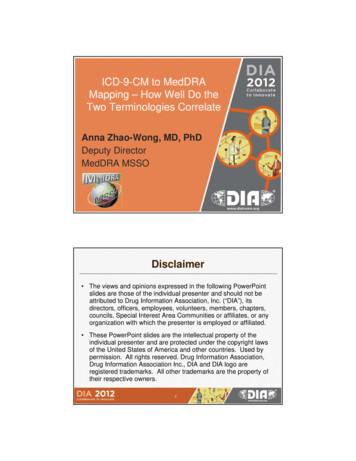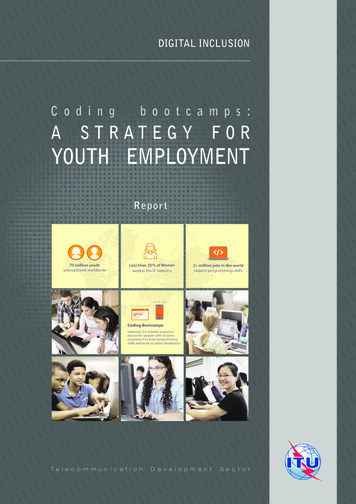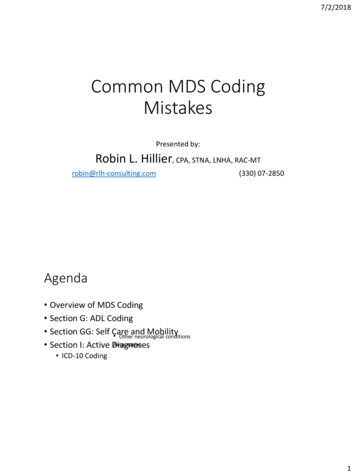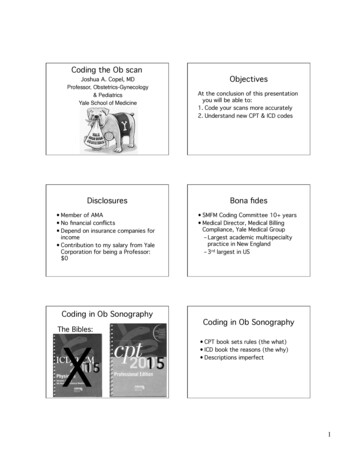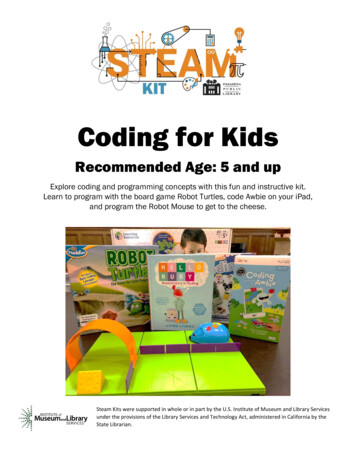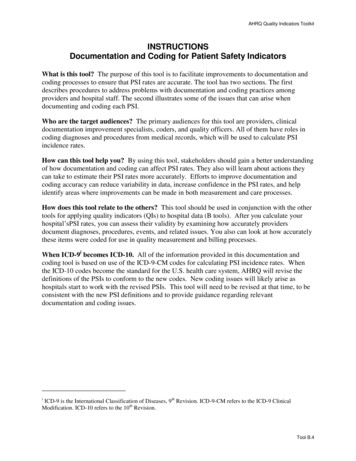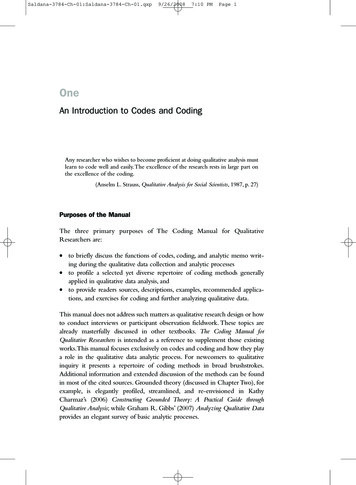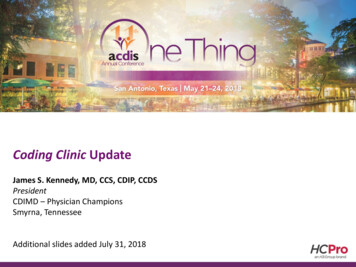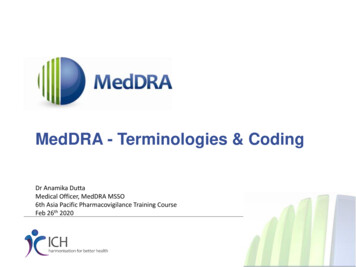
Transcription
MedDRA - Terminologies & CodingDr Anamika DuttaMedical Officer, MedDRA MSSO6th Asia Pacific Pharmacovigilance Training CourseFeb 26th 2020
Disclaimer andCopyright Notice This presentation is protected by copyright and may, with the exception of theMedDRA and ICH logos, be used, reproduced, incorporated into other works,adapted, modified, translated or distributed under a public license provided thatICH's copyright in the presentation is acknowledged at all times. In case of anyadaption, modification or translation of the presentation, reasonable steps mustbe taken to clearly label, demarcate or otherwise identify that changes weremade to or based on the original presentation. Any impression that the adaption,modification or translation of the original presentation is endorsed or sponsoredby the ICH must be avoided. The presentation is provided "as is" without warranty of any kind. In no eventshall the ICH or the authors of the original presentation be liable for any claim,damages or other liability arising from the use of the presentation. The above-mentioned permissions do not apply to content supplied by thirdparties. Therefore, for documents where the copyright vests in a third party,permission for reproduction must be obtained from this copyright holder.2
Coding? What is Coding ? Why code?3
How does this look to you?4
What do you see ?5
What is MedDRA?Med MedicalD Dictionary forR RegulatoryA ActivitiesMedDRA is a clinically-validated international medicalterminology used by regulatory authorities and theregulated biopharmaceutical industry. The terminology isused through the entire regulatory process, from premarketing to post-marketing, and for data entry, retrieval,evaluation, and presentation.6
MedDRA Data Sharing Subscription grants access to MedDRA for one year Subscriber cannot grant any sublicense, publish orotherwise distribute MedDRA to a third party Data may be freely exchanged between currentMedDRA subscribers–Sponsor-sponsor, sponsor-CRO, vendor-user, etc.–Use Self-Service Application to check organization’ssubscription status Sharing MedDRA with a non-subscribingorganization is a violation of the MedDRA license0002817
2019 MedDRASubscription Rate Table77% of all MedDRAusers pay no fee or 654 (or less)8
How to subscribe?9
Scope of MedDRANot a drugdictionaryPatient demographictermsClinical trial studydesign termsOUTINFrequencyqualifiersMedical conditionsIndicationsInvestigations (tests, results)Numerical values forMedical and surgical proceduresresultsMedical, social, family historyMedication errorsProduct quality issuesDevice-related issuesProduct use issuesSeverity descriptorsPharmacogenetic termsToxicologic issuesStandardized queriesNot an equipment, device,diagnostic product dictionary10
MedDRA StructureSystem Organ Class (SOC) (27)High Level Group Term (HLGT) (337)High Level Term (HLT) (1,737)Preferred Term (PT) (23,708)Lowest Level Term (LLT) (80,262)000289MedDRA Version 22.011
System Organ Classes Blood and lymphatic system disordersCardiac disordersCongenital, familial and genetic disordersEar and labyrinth disordersEndocrine disordersEye disordersGastrointestinal disordersGeneral disorders and administration siteconditionsHepatobiliary disordersImmune system disordersInfections and infestationsInjury, poisoning and proceduralcomplicationsInvestigationsMetabolism and nutrition disorders Musculoskeletal and connective tissuedisordersNeoplasms benign, malignant and unspecified(incl cysts and polyps)Nervous system disordersPregnancy, puerperium and perinatalconditionsProduct issuesPsychiatric disordersRenal and urinary disordersReproductive system and breast disordersRespiratory, thoracic and mediastinal disordersSkin and subcutaneous tissue disordersSocial circumstancesSurgical and medical proceduresVascular disorders12
Lowest Level TermSynonyms, lexical variants, sub-elementsSOC Cardiac disordersHLGT Cardiac arrhythmiasHLT Rate and rhythm disorders NECPT miasLLT (Non-current)Other specified cardiacdysrhythmiasNot all LLTs shown13
Non-Current Terms Flagged at the LLT level in MedDRA Not recommended for continued use Retained to preserve historical data forretrieval and analysis Terms that are vague, ambiguous, outdated, truncated, or misspelled Terms derived from other terminologiesthat do not fit MedDRA rules14
Codes and Languages15
A Multi-Axial Terminology Multi-axial the representation of a medicalconcept in multiple SOCs– Allows grouping by different classifications– Allows retrieval and presentation via different data sets All PTs assigned a primary SOC– Determines which SOC will represent a PT duringcumulative data outputs– Prevents “double counting”– Supports standardized data presentation– Pre-defined allocations should not be changed by users16
A Multi-Axial Terminology(cont)SOC Respiratory, thoracic andmediastinal disorders(Secondary SOC)SOC Infections andinfestations(Primary SOC)HLGT Respiratory tractinfectionsHLGT Viral infectiousdisordersHLT Viral upper respiratorytract infectionsHLT Influenza viralinfectionsPT Influenza17
What are coding conventions?00028918
ICH MedDRA Coding GuideMedDRA Term Selection: Points to Consider (MTS:PTC) Provides term selection advicefor industry and regulatorypurposes Objective is to promoteaccurate and consistent termselection to facilitate acommon understanding ofshared data Recommended to be used asbasis for individualorganization’s own codingconventions19
General Term SelectionPrinciples Quality of Source DataQuality AssuranceDo Not Alter MedDRAAlways Select a Lowest Level TermSelect Only Current Lowest Level TermsWhen to Request a TermUse of Medical Judgment in Term SelectionSelecting More than One TermCheck the HierarchySelect Terms for All Reported Information, Do NotAdd Information20
Term Selection Points Diagnoses and Provisional Diagnoses with or without Signs andSymptoms Death and Other Patient Outcomes Suicide and Self-Harm Conflicting/Ambiguous/Vague Information Combination Terms Age vs. Event Specificity Body Site vs. Event Specificity Location-Specific vs. Microorganism-Specific Information Modification of Pre-existing Conditions Exposures During Pregnancy and Breast Feeding Congenital Terms Neoplasms Medical and Surgical Procedures Investigations21
Term Selection Points(cont) Medication Errors, Accidental Exposures and OccupationalExposures Misuse, Abuse and Addiction Transmission of Infectious Agent via Product Overdose, Toxicity and Poisoning Device-related Terms Drug Interactions No Adverse Effect and “Normal” Terms Unexpected Therapeutic Effect Modification of Effect Social Circumstances Medical and Social History Indication for Product Use Off Label Use Product Quality Issues22
Some Points to consider Obtain clarification of data that are ambiguous,confusing, or unintelligible Do Not Alter MedDRA :Users must not make adhoc structural alterations, including changing theprimary SOC allocation Avoid company-specific “work-arounds” forMedDRA deficiencies, submit change request toMSSO Select current LLTs only–Non-current terms for legacy conversion/historicalpurposes23
Some Points to consider Lowest Level Term that most accurately reflects thereported verbatim information should be selected Degree of specificity may be challenging–Example: “Abscess on face” select “Facialabscess,” not simply “Abscess” If no exact match in MedDRA, use medical judgmentto match to an existing term that adequatelyrepresents the concept Check the hierarchy above a selected LLT (PT, HLT,HLGT, SOC) to ensure placement accurately reflectsmeaning of reported term24
Some Points to consider Can select more than one LLT to represent reportedinformation. Document procedures. Select terms for every AR/AE reported, regardless ofcausal association Select terms for device-related events, product qualityissues, medication errors, medical and social history,investigations and indications as appropriate Do not make diagnosis if only signs/symptomsreported25
MedDRA Browser & Demonstration26
MSSO’s MedDRABrowsers MedDRA Desktop Browser (MDB)– Download MDB and release files from MedDRA website MedDRA Web-Based Browser (WBB)– https://tools.meddra.org/wbb/ Features– Both require MedDRA ID and password– View/search MedDRA and SMQs– Support for all MedDRA languages– Language specific interface– Ability to export search results and Research Bin to localfile system27
Assessing the ReportedInformation Consider what is being reported. Is it a:–––––––––––Clinical condition - Diagnosis, sign or symptom?Indication?Test result?Injury?Procedure?The type of report willMedication error?influence the way youProduct use issue?search for a suitable LLT.Product quality issue?It may indicate in whichSocial circumstance?SOC you expect to findDevice issue?the closest match.Procedural complication?– Is it a combination of these?28
Coding Example 1SpecificityThe patient suffered from an allergic reaction to anantibiotic29
Coding Example 2SymptomsThe patient states she has been experiencing coldsweats30
Coding Example 3InvestigationsLab results indicate the patient has increasedtroponin and increased CPK-MB31
Coding Example 4Patient demographicsA 2 day old baby was noted to have a mild fever32
Coding Example 5IndicationsA 35 year old woman was taking Drug X to preventrelapses of multiple sclerosis33
Coding Example 6Product quality issuesIt was determined that the product was counterfeit34
Coding Example 7Social circumstancesThe patient was confined to a wheelchair35
Coding Example 8Medication errors/Product use errors and issuesThe pharmacist made a mistake in compoundingthe medication36
MedDRA Coding Exercise37
Which LLT Would YouSelect?Verbatim: “Man with decreased fertility.”A. InfertilityB. Fertility decreased maleC. Infertility maleD. Fertility decreased38
Which LLT Would YouSelect?Verbatim: “Became color blind in adolescence”A. Color blindnessB. Blindness colorC. Colour blindness acquiredD. Color blindness acquired39
Which LLT Would YouSelect?Verbatim: “Turned very greasy”A. Ill-defined disorderB. Unevaluable eventC. Skin greasyD. Unevaluable reaction40
Which LLT Would YouSelect?Verbatim: “Deliberately took an overdose”A. Intentional overdoseB. Overdose NOSC. Deliberate overdoseD. Overdose41
Which LLT Would YouSelect?Verbatim: “Toddler accidentallytook her mother’s medication”A. Accidental overdoseB. Accidental exposure to productby childC. Accidental drug intake by childD. Accidental ingestion42
Which LLT Would YouSelect?Verbatim: “Infection after surgery”A. InfectionB. Postoperative wound infectionC. Surgical wound infectionD. Postoperative infection43
Which LLT Would YouSelect?Verbatim: “He sold his father’s medication”A. Drug diversionB. Intentional product misuseC. Drug use for unapproved indicationD. Intentional drug misuse44
Which LLT Would YouSelect?Verbatim: “Had MI”A. Myocardial infarctionB. Ill-defined disorderC. MID. Unevaluable event45
Which LLT Would YouSelect?Verbatim:“Hypernatraemia (Serum sodium 115 mEq/L)”A.B.C.D.Serum sodium abnormalHypernatraemiaHyponatraemiaSerum sodium decreased46
Which LLT Would YouSelect?Verbatim: “Took intramuscular drug by mouth”A. Wrong route of administrationB. Drug administered via inappropriate routeC. Medication errorD. Intramuscular formulation administered byother route47
Which LLT Would YouSelect?Verbatim: “The doctor mistakenlyprescribed the wrong drug; thepharmacist noticed the error beforedispensing the drug”A. Wrong drug dispensedB. Medication errorC. Intercepted drug prescribing errorD. Intercepted drug dispensing error48
Which LLT Would YouSelect?Verbatim: Patient attempted to commitsuicide by walking into the sea; unfortunately,he could swimA. Suicidal behaviourB. Attempted suicideC. Completed suicideD. Death49
Which LLT Would YouSelect?Verbatim: “Dose taken was below theminimum recommended dose in the productlabel”A. UnderdoseB. Drug administration errorC. Accidental underdoseD. Incorrect dosage administered50
Which LLT Would YouSelect?Verbatim: “After taking an antihistamine alongwith her prescribed proton pump inhibitor, a 53year-old woman developed vertigo.”A.B.C.D.Drug interaction NOSVertigo subjectiveVertigoDrug interaction51
Which LLT Would YouSelect?Verbatim: “The medication was stored atroom temperature instead of in therefrigerator where it belonged.”A. Incorrect storage of drugB. Improper storage of unused productC. Intercepted medication errorD. Product storage error temperature too high52
Which LLTs Would YouSelect?Verbatim: The 66 year old man died from aruptured aortic aneurysmA.B.C.D.E.Aortic aneurysm ruptureAscending aortic aneurysm ruptureDissecting aortic aneurysm, rupturedDeathA & D both53
Quick Guess? Hippo tension Mousy feeling in chest Patient recently began new job where he worksaround chicken wings and barbecue sauce Loss of brain Spray it in the nose as much as you want and theSeptum is gone Medication messed up with the brain Adult teeth came in three different colors – yellow,green and white Husband had his uterus scrapped and frozen Death-worsened clinically by end of 4 hrs rx Even Need to spend more time with my wife (as thesubject stated)54
After Coding?55
How is MedDRA Used forAnalysis? MedDRA can be used to summarise large volumes of data– Standard approach is to list data at PT and SOC levels foroverview Focused searches can be made using features of MedDRA– Searching for specific PTs– Summarising at HLT or HLGT levels– Using multiaxial links to group diagnoses with signs andsymptoms– Selecting a set of relevant PTs which reflect the condition ofinterest– Using Standardised MedDRA Queries (SMQs) for signaldetection– Customized search /Modified MedDRA Queries56
More on SMQ and DataRetrieval ? Documentation : SMQ Introductory umentation Processes : MedDRA Data Retrieval and Presentation: Points to documentation Training : Face-to-Face Training - MedDRA: Safety Data Analysis and SMQs Webinar Training 57
Know more? Visit : www.meddra.org58
Thank You!! anamika.dutta@meddra.org mssohelp@meddra.org
Codes and Languages 15. A Multi-Axial Terminology Multi-axial the representation of a medical concept in multiple SOCs –Allows grouping by different classifications –Allows retrieval and presentatio
